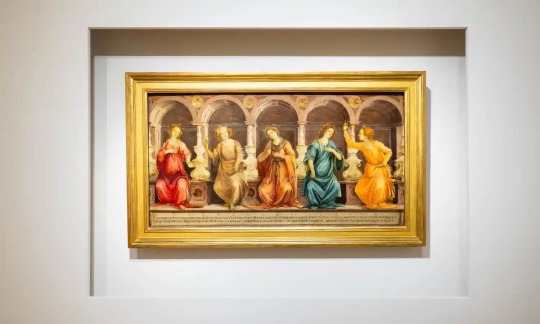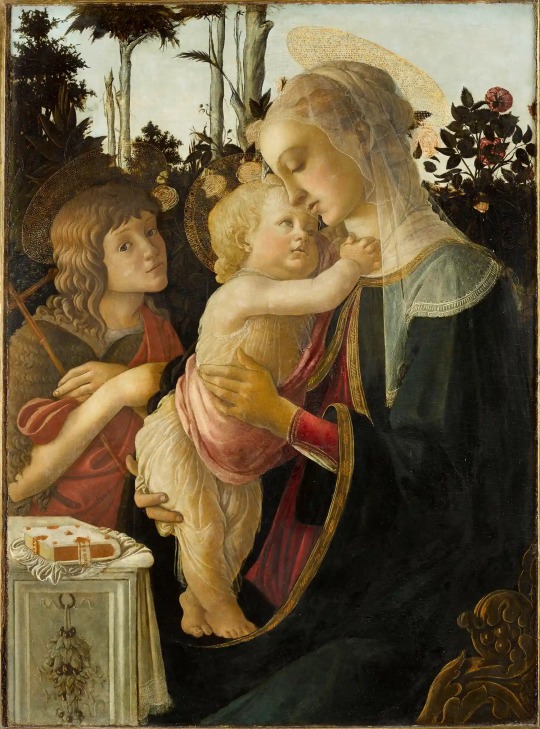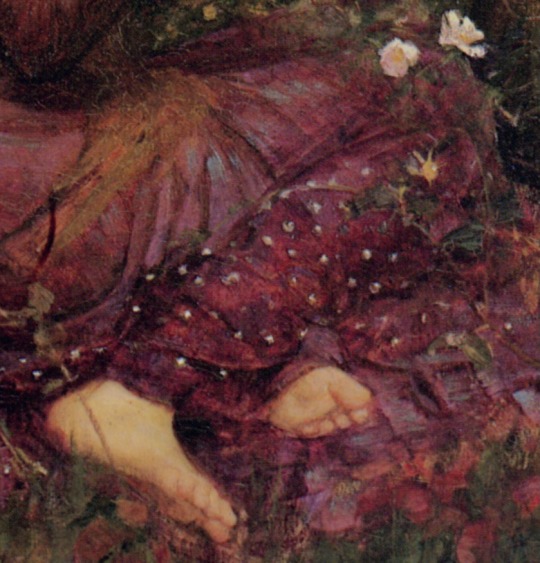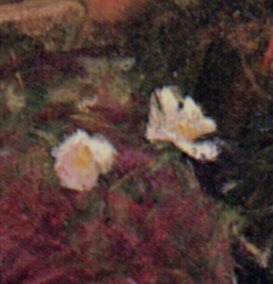#Hessisches Landesmuseum
Text
It’s #InternationalPolarBearDay! #DYK Polar Bears are the biggest, most aquatic, and most carnivorous of the world’s 8 living bear species?

Polar bear by Christian Wilhelm Kehrer (German, 1775-1869), 1820, oil on canvas. Hessisches Landesmuseum Darmstadt.
#polar bear#bear#painting#oil painting#19th century art#European art#German art#Christian Wilhelm Kehrer#Hessisches Landesmuseum Darmstadt#International Polar Bear Day#animals in art
256 notes
·
View notes
Photo

Vera Röhm, Winkel-Ergänzung Beta 75, (pencil, chalk, charcoal, red chalk on laid paper), 1986 [Hessisches Landesmuseum Darmstadt, Darmstadt. © Vera Röhm]
37 notes
·
View notes
Text


Marble sarcophagus with the Triumph of Dionysos and the Seasons x
The sarcophagus is an exquisite example of Roman funerary art, displaying all the virtuosity of the workshop where it was carved. The marble comes from a quarry in the eastern Mediterranean and was probably shipped to Rome, where it was worked. Only a very wealthy and powerful person would have been able to commission and purchase such a sarcophagus, and it was probably made for a member of one of the old aristocratic families in Rome itself. The subjects - the triumph of Dionysos and the Seasons - are unlikely, however, to have had any special significance for the deceased, particularly as it is clear that the design was copied from a sculptor's pattern book. Another sarcophagus, now in the Hessisches Landesmuseum in Kassel, Germany, has the same composition of Dionysos flanked by the four Seasons, although the treatment and carving of the figures is quite different. On the Badminton sarcophagus the figures are carved in high relief and so endow the crowded scene with multiple areas of light and shade, allowing the eye to wander effortlessly from one figure to another. One must also imagine that certain details were highlighted with color and even gilding, making the whole composition a visual tour de force.
253 notes
·
View notes
Photo

Eugen Bracht (1842–1921), The Shore of Oblivion (detail) (1889), oil on canvas, 139 x 257 cm, Hessisches Landesmuseum Darmstadt, Darmstadt, Germany.
via
57 notes
·
View notes
Text

“Winged Orchid” pendant by Philippe Wolfers, c. 1902 (Hessisches Landesmuseum, Darmstadt, Germany)
One of the finest independent craftsmen working in the French style of Art Nouveau jewelry at the turn of the 20th century was actually Belgian. Philippe Wolfers.
12 notes
·
View notes
Photo

“Winged Orchid” pendant by Philippe Wolfers, c. 1902 (Hessisches Landesmuseum, Darmstadt, Germany)
2 notes
·
View notes
Text

Sandro Botticelli — The Devout Jews at Pentecost, ca 1505. Photograph: Wolfgang Fuhrmannek/Hessisches Landesmuseum Darmstadt
‘Perfect Linearity’: Why Botticelli’s Drawing Abilities Remain One-of-a-Kind
An Expansive Exhibition in San Francisco Brings Together the Artist’s Influential Work, Including Five Newly Attributed Pieces
— Veronica Esposito | Wednesday 29 November 2023
Throughout the Renaissance, drawings became an integral part of the massive paintings and frescoes that have long been associated with that period. Among other things, they were a way for artists to get a feel for how to arrange the space of a composition, and they also helped artists hone the incredibly lifelike poses that have become synonymous with masterworks from the likes of Leonardo da Vinci, Tiziano Vecellio (better known as Titian) and Tintoretto. Drawings were even used in legally binding contracts to provide a reference point for the work that was being agreed to.
When it came to drawings, Sandro Botticelli was in a class of his own, with one expert even touting him as “the greatest artist of linear design that Europe has ever had”. Botticelli’s line became the basis for the dance-like aesthetic that permeates his output and that can be seen in masterworks like Birth of Venus and La Primavera. According to Italian Renaissance expert Furio Rinaldi, “Botticelli’s use of drawing goes to the core meaning of the word ‘choreography’ … With his drawings, Botticelli is writing the composition, drawing the dance.”
For San Francisco’s Legion of Honor museum, Rinaldi has curated an exciting new exhibition centering around Botticelli’s drawings. Featuring 27 of the artist’s drawings – including five newly attributed – and more than 60 works overall from dozens of lenders, it offers Bay Area audiences a rare opportunity to see one of the largest shows of the Italian master’s work ever attempted.
“It was an incredible effort that took more than three years to organize,” said Rinaldi during an interview in his office at the Legion of Honor. “In my mind there is something really incredible about Botticelli being in San Francisco, so far away from where he worked. For many it will probably be the only opportunity to see so many works by this great artist.”

Botticelli Drawings Black Tie Dinner San Francisco, CA — November 17 — Atmosphere at Botticelli Drawings Black Tie Dinner on November 17th 2023 at Legion of Honor in San Francisco, CA (Photo - Drew Altizer) Photograph: Drew Altizer/Drew Altizer Photography
As with many painters of the era, Botticelli relied on drawings throughout his creative process to help hone and shape forms that would eventually come together as a painting. What Botticelli Drawings attempts to show is how integral these sketches were to the unique qualities that made Botticelli stand out from his contemporaries, and that have made his artworks resonate for more than 500 years and be referenced in everything from The Simpsons to the cover of Lady Gaga’s 2013 album Artpop. “We’re really leaning into his mind and into his graphic articulations of his ideas,” said Rinaldi. “They’re so essential to the aesthetic that makes Botticelli so appealing, because the linearity of these sketches are really a reflection of his painting technique.”
The works on display at the Legion of Honor are quite masterful. Here audiences will see renderings of the human form that appear so lifelike that they could very well walk up off of the page. As this exhibition demonstrates, these forms often seem as though in motion – whether jumping back in fear amid a fight, running to announce the incarnation of Jesus Christ or hefting high a decapitated head, the subjects of Botticelli’s drawing seem to be dancing, moving with a fluidity and lithe presence that makes these figures quite different from others. “I tried to really go beyond to the core of this attraction and magnetism,” said Rinaldi. “A lot of contemporary artists and dancers are inspired by Botticelli. And I felt that the common thread was the line, the perfect linearity of Botticelli’s composition.”
With Botticelli’s drawings centered in this exhibition, each of the show’s galleries also includes one finished painting to offer a point of synthesis for audiences. Works shown here include such major pieces as The Virgin and Child With the Young Saint John the Baptist and The Adoration of the Magi, including paintings that rarely if ever have traveled to the US. These paintings help audiences to get a sense of how Botticelli’s drawings were a part of the creative process that ultimately ended in a work on canvas. “Every room has a seminal painting,” said Rinaldi, “a significant work to help the audience anchor and recompose the ideas and the figures that they see scattered in the drawings.”

Madonna and Child With the Young Saint John the Baptist. Photograph: RMN-Grand Palais/Art Resource/Tony Querrec
Staging a show of Botticelli’s drawings was a significant challenge that took over three years to complete. This was partly due to the fact that, although Botticelli is recognized as an innovator and master of the drawing, only a scant two dozen of his have survived until modern times. “There are very, very few drawings that have survived that can be attributed to Botticelli,” said Rinaldi. “If you think of Leonardo da Vinci, we have almost thousands of his drawings. For other artists, there may be hundreds. For Botticelli we have by my count no more than 30 sheets.” Because Botticelli died in poverty, his drawing workshop was not preserved and sustained as were those of many of his contemporaries, instead being sold off after his death. “If you think of Leonardo da Vinci or Michelangelo, there’s a slightly different situation where they all have their pupils continuing their workshop and preserving and using the drawings as a sort of visual patrimony of the artist’s ideas.”
One thing that stands out about Botticelli Drawings is the very sleek, minimalist presentation of the works. The Legion of Honor’s galleries have been pared back in a way that gives the show a very polished, contemporary feeling, almost as though it’s borrowing from the very clean, bright aesthetic of the Apple Store. “I wanted to put the audience in the best possible position to appreciate this work, so you will see a very sparse hang,” said Rinaldi. “Everything is just very clean and very modern. Even if the exhibition is firmly grounded in art historical research, I am trying to remove Botticelli from the art historical mythologies.” The result of Rinaldi’s aesthetic makes for an interesting, and certainly original, feeling.
Ultimately, Botticelli Drawings succeeds in presenting the artist in a different way, one that resonates and allows us to look at his work as though for the first time. It is a major show – a welcome chance to see pieces that rarely travel anywhere, let alone to the United States, and to have a deep look into the intimacy of the creative process of an artist who comes from a very different world than the one in which we live. “Renaissance Florence is so far away in time and place that people don’t even know what it means anymore,” said Rinaldi. “I think it’s time to turn the leaf and look at these artists with today’s eyes.”
— Botticelli Drawings is showing at the Legion of Honor Museum in San Francisco until 11 February 2024
#Sandro Botticelli | Art and Design | Drawing | Painting#Art | Culture | Exhibitions | Article | Features#Veronica Esposito#The Guardian USA 🇺🇸
1 note
·
View note
Text
Kurfürstliches Schloss
Als eine der bekanntesten Sehenswürdigkeiten in Offenbach am Main ist das Kurfürstliche Schloss ein Muss für jeden Besucher. Es wurde im 18. Jahrhundert erbaut und ist ein wichtiges Kulturdenkmal im Herzen der Stadt. Es beherbergt eine Vielzahl an Kunstwerken und Kunstausstellungen, die auf die Geschichte der Stadt und die Kultur der Region verweisen.
Das Schloss ist ein beliebtes Ziel für Touristen und Einheimische, die sich für die Geschichte und Kultur der Stadt interessieren. Es bietet eine Vielzahl an Exponaten, die die Geschichte der Region beleuchten, sowie ein Museum, das die kulturellen Einflüsse der Region aufzeigt.
Das Schloss ist auch ein beliebter Ort für Veranstaltungen und Konzerte. Es gibt regelmäßig Konzerte und andere Veranstaltungen, die Besuchern die Möglichkeit bieten, die Atmosphäre des Schlosses und die Kultur der Stadt zu erleben.
Kunsthalle Schirn
Die Kunsthalle Schirn ist ein weiteres Highlight in Offenbach am Main. Es ist ein modernes Museum, das Kunstwerke aus der ganzen Welt ausstellt. Es ist bekannt für seine Ausstellungen von zeitgenössischer Kunst und bietet ein vielfältiges Programm an Veranstaltungen.
Es ist ein beliebtes Ziel für Kunstinteressierte und Kulturliebhaber. Es bietet eine Vielzahl an Exponaten, die Kunstwerke aus verschiedenen Epochen und Regionen repräsentieren. Es gibt auch ein umfangreiches Programm an Veranstaltungen, die Besuchern die Möglichkeit bieten, sich über Kunst und Kultur zu informieren.
Stadtmuseum Offenbach
Das Stadtmuseum Offenbach ist ein weiteres Highlight in der Stadt. Es ist ein modernes Museum, das die Geschichte und Kultur der Stadt beleuchtet. Es beherbergt eine Vielzahl an Exponaten, die die Geschichte der Stadt beleuchten, sowie ein Museum, das die kulturellen Einflüsse der Region aufzeigt.
Es bietet ein umfangreiches Programm an Veranstaltungen, die Besuchern die Möglichkeit bieten, sich über die Geschichte und Kultur der Stadt zu informieren. Es gibt auch eine Vielzahl an Kunstausstellungen, die auf die Geschichte der Stadt und die Kultur der Region verweisen.
Stadtpark Offenbach
Der Stadtpark Offenbach ist ein weiteres beliebtes Ausflugsziel in der Stadt. Es ist ein großer Park, der zahlreiche Grünflächen und Gärten beherbergt. Es ist ein beliebter Ort für Spaziergänge und Picknicks und bietet eine Vielzahl an Freizeitmöglichkeiten.
Es gibt auch ein Museum im Park, das die Geschichte der Stadt beleuchtet. Es bietet eine Vielzahl an Exponaten, die die Geschichte der Stadt beleuchten, sowie ein Museum, das die kulturellen Einflüsse der Region aufzeigt.
Hessisches Landesmuseum
Das Hessische Landesmuseum ist ein weiteres Highlight in Offenbach am Main. Es ist ein modernes Museum, das die Geschichte und Kultur des Bundeslandes beleuchtet. Es beherbergt eine Vielzahl an Exponaten, die die Geschichte des Landes beleuchten, sowie ein Museum, das die kulturellen Einflüsse der Region aufzeigt.
Es bietet ein umfangreiches Programm an Veranstaltungen, die Besuchern die Möglichkeit bieten, sich über die Geschichte und Kultur des Bundeslandes zu informieren. Es gibt auch eine Vielzahl an Kunstausstellungen, die auf die Geschichte des Landes und die Kultur der Region verweisen.
Stadtbibliothek Offenbach
Die Stadtbibliothek Offenbach ist ein weiteres Highlight in der Stadt. Es ist eine moderne Bibliothek, die eine Vielzahl an Büchern und anderen Informationsquellen anbietet. Es ist ein beliebter Ort für Leseratten und Kulturliebhaber und bietet eine Vielzahl an Veranstaltungen, die Besuchern die Möglichkeit bieten, sich über Literatur und Kultur zu informieren.
Fazit
Offenbach am Main hat eine Vielzahl an Sehenswürdigkeiten zu bieten, die für jeden Besucher eine interessante Erfahrung bieten. Von Kunstmuseen über historische Gebäude bis hin zu Parks und Bibliotheken gibt es viel zu entdecken. Jede Sehenswürdigkeit in Offenbach am Main bietet Besuchern die Möglichkeit, sich über die Geschichte und Kultur der Stadt zu informieren und einzigartige Erfahrungen zu machen.
0 notes
Text





La Belle Dame sans Merci [fr.]
The Beautiful Lady Without Mercy + details.
John William Waterhouse (1849-1917)
Victorian neoclassicism. Pre-raphaelite brotherhood.
Ca.1893. Oil on canvas.
Hessisches Landesmuseum (Darmstadt, Germany)
This one is inspired by John Keats’ poem of the same name, as many others. So here is a fragment:

“This phrase—and the poem’s title—is from Alain Chartier’s courtly French ballad, “La Belle Dame sans Merci” (1424). Keats wrote the poem in a letter to George and Georgiana Keats, April 21, 1819”
#la belledame sans merci#the beautiful lady without mercy#john william waterhouse#19th Century#XIX century#1893#pre-raphaelite#pre raphaelism#hessisches landesmuseum#darmstadt#germany#oiloncanvas#Victorian Neoclassicism#art#painting#mythology#Greek Mythology#english painter#robinird#woman#knight#quotes
30 notes
·
View notes
Text
Frankfurt Vacation Travel Guide | Expedia
Frankfurt Vacation Travel Guide | Expedia
Frankfurt – Welcome to one of Europe’s most important trading capitals. Check out the best places to visit in Frankfurt and start planning your trip! When ready …

View On WordPress
#Alte Oper#cvg#Darmstadt#Eiserner Steg#frankfurt#Frankfurt Cathedral#German Architecture Museum#German Leather Museum#germany#Goethe House#Hessisches Landesmuseum#Historical Museum#Maintower#Museumsufer#Offenbach#Palmengarten#Roemer#Senckenberg Museum#St. Paul&039;s Church#Staedel Museum
0 notes
Photo

Ceremonial box for the wedding of Helene von Mecklenburg to Prince Ferdinand Philippe, Fossin & Fils, Paris, 1837 - Hessisches Landesmuseum Darmstadt - Darmstadt, Germany
1 note
·
View note
Photo

Italian Pastoral Landscape with the Temple of Vespasian, Johann Heinrich Roos, 1668
#art#art history#Johann Heinrich Roos#landscape#landscape painting#pastoral#ruins#capriccio#Italy#Italianate#Baroque#Baroque art#German Baroque#German art#17th century art#Hessisches Landesmuseum Darmstadt
115 notes
·
View notes
Photo







Hessisches Landesmuseum Darmstadt
Heute wäre der erste Tag der Eröffnung unserer Sonderausstellung »Peter Lindbergh: Untold Stories« gewesen. Den aktuellen Gegebenheiten geschuldet, müssen wir diesen Moment vorerst leider verschieben.
Nichtsdestotrotz: Lasst uns einfach virtuell anstoßen und dabei einen kleinen digitalen Einblick in die Ausstellung genießen!
Wir freuen uns schon sehr, Sie hoffentlich ganz bald in echt durch die Ausstellung führen zu können!
Mehr Infos https://www.hlmd.de/.../peter-lindberg-untold-stories.html
Fotos: A. E., HLMD
0 notes
Photo

Bouquet of Flowers
by Peter Binoit
Hessisches Landesmuseum, Darmstadt, Germany
9 notes
·
View notes
Photo

Velde, Henry van de, Furnishings from the editorial staff room of La Revue Blanche, 1899, Various woods, Hessisches Landesmuseum, Darmstadt (via wga.hu)
2 notes
·
View notes